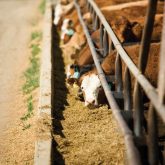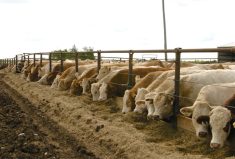Glacier FarmMedia – A transgenic corn variety originally developed for the U.S. ethanol industry is being officially launched by Syngenta in Canada in 2023 for cattle feed.
The Enogen line of hybrids contains a bacteria-derived transgene that produces alpha amylase, a naturally occurring enzyme that speeds the breakdown of starch. Since its introduction in the U.S. in 2012, the line has expanded to include maturity ratings ranging from 80 to 118 days. Adherence to a stewardship contract has been required for anyone growing Enogen to prevent contamination of the conventional corn supply with the hybrids, as their rapid starch digestibility could affect the quality of foods made using corn.
Before Enogen’s introduction, alpha amylase was artificially added during ethanol production, so it seemed an ideal product for the then-booming U.S. ethanol industry. Additional American research found that alpha amylase also enhanced the feed efficiency of corn fed to cattle as grain and silage.
Read Also

Mosquito-borne virus could be devastating to sheep breeding operations
Cache Valley virus, a mosquito-borne disease that infects small ruminants, could be a devastating hit to small operations.
[RELATED] It’s good to be green — canola cleared under new ‘clean fuel’ regulations
Syngenta’s marketing of Enogen has gradually shifted to its benefits for beef and dairy producers. With its launch in Canada in 2023, it is being promoted with an identity-preserved-style stewardship contract, used solely as animal feed, with strict growing, harvesting and transporting protocols.
According to Syngenta Canada’s sales representative Doug Helm, “a limited number of commercial growers” grew Enogen hybrids in 2022 in Canada and they will be available across the country for the 2023 crop year.
“We’re excited for growers to use Enogen to help improve feed efficiency on their operations,” said Helm.
A recent U.S. financial assessment by the University of Wisconsin-Madison evaluated factors such as milk content, expected milk revenue and associated corn silage costs.
“Syngenta found that when comparing Enogen corn to traditional feed products, a U.S. dairy farm operation could potentially yield a financial savings of $132 to $208 per milking cow,” said a news release about the research.
Helm said other research conducted by third-party institutions has also demonstrated the feed efficiency of grain and silage with the Enogen trait.
[RELATED] Feed situation is much improved this year but far from perfect
There were no trial plots grown north of the border until the 2022 crop year, he said, but “Syngenta Canada continues to develop information to demonstrate the benefits of Enogen to Canadian growers.”
Other benefits shown through U.S. studies indicate Enogen silage is less prone to spoilage upon exposure to oxygen than some other hybrids, and leads to higher silage quality related to better stability.
There are environmental benefits that could “could be significant,” Helm said.
“For example, increasing feed efficiency by about five per cent per 1,000 lactating cow herd could lower emissions of greenhouse gases (at a rate that would be) equivalent to removing 314 passenger cars from the road for one year,” he said.
The University of Wisconsin assessment led to sustainability related findings for the decreased amount of land needed to grow silage for the 1,000-cow herd, less energy needed to grow the corn and less water needed from seed to feed.
“In terms of sustainability specifically, we are just getting started with Enogen here in Canada,” Helm said.















